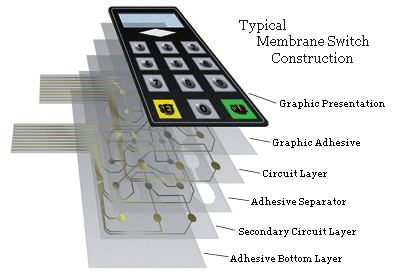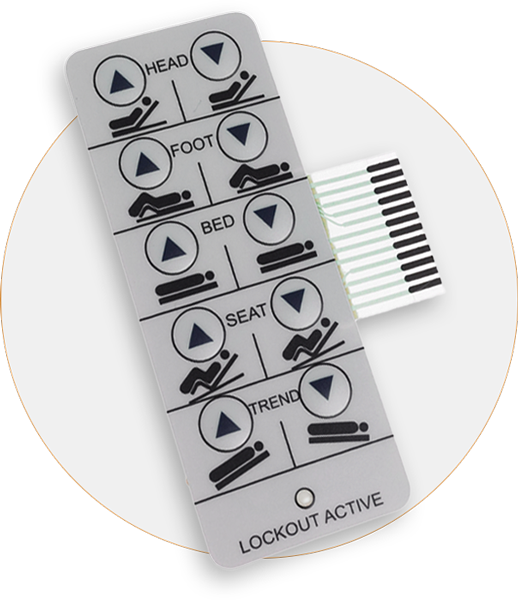Don’t ignore the value of working with a proven membrane switch manufacturer for mock-ups.
Don’t ignore the value of working with a proven membrane switch manufacturer for mock-ups.
Blog Article
What to Seek When Choosing a Membrane Layer Change for Your Job
When you're choosing a membrane switch for your project, a number of essential aspects come right into play. You'll require to assume concerning the materials, design, and just how well it lines up with your brand.
Understanding Membrane Change Elements
When you dive into the globe of membrane layer buttons, it's important to realize the crucial parts that make them work. Below that, the spacer layer assurances there's adequate range between the circuit and the overlay, enabling the button to turn on without constant pressure.
Understanding just how these layers function together aids you select a membrane layer switch that's trustworthy and fits your project requirements. Pay close attention to the density and material of each layer, as these variables affect toughness and functionality in numerous atmospheres.
Product Option and Its Impact
Choosing the best materials for your membrane layer switch can considerably influence its efficiency and durability. The choice of substratum, commonly polyester or polycarbonate, affects longevity and flexibility. Polyester is a lot more abrasion-resistant, while polycarbonate supplies better quality and strength.
Next, take into consideration the adhesive. It requires to withstand ecological elements like wetness and temperature modifications. A solid sticky warranties that your membrane button remains intact over time.
Don't forget the visuals overlay. The printing method utilized, whether silkscreen or digital, influences the switch's aesthetic appeals and longevity. High-grade inks will certainly stand up to fading and damaging, preserving a specialist appearance.
Last but not least, assume regarding environmental problems. If your tool will certainly be exposed to harsh chemicals or extreme temperature levels, pick products made to endure these challenges. Your choices in materials will ultimately identify the switch's dependability and customer contentment.
Layout Factors To Consider for Customer Experience
Choosing the appropriate materials lays the structure for a successful membrane button, but the style additionally plays a considerable duty in user experience. You'll wish to review exactly how the format impacts use (membrane switch manufacturer). Maintain switches and icons instinctive and well-spaced, making it simple for customers to browse without confusion

Color and comparison are also important; warranty that your style is visually attractive however still practical. High contrast aids customers quickly recognize buttons, particularly in low-light conditions.
Last but not least, assess the overall aesthetic. A sleek and contemporary layout can boost user assumption and make your item much more enticing. Stabilizing functionality with an engaging style will bring about a better customer experience and ultimately, an extra effective item.

Environmental Aspects and Toughness
When choosing a membrane button, you need to take into account how it'll do in different atmospheres. Factors like temperature level resistance, moisture and chemical exposure, and mechanical wear can greatly impact its durability. Recognizing these elements will certainly help you choose a button that withstands your specific problems.
Temperature Resistance Requirements
As ecological conditions can differ widely, recognizing temperature level resistance is necessary for guaranteeing the longevity of your membrane button. You need to evaluate the temperature level range in which your tool will run. High temperature levels can create materials to degrade, bring about failure, while low temperatures could make elements brittle and vulnerable to splitting. Ensure to check the specifications of the products used in the button, like the sticky and overlay, as they directly influence efficiency. It's also a good idea to ponder prospective temperature fluctuations and their impacts on the button's reliability. By selecting a membrane switch with appropriate temperature level resistance, you'll enhance its lifespan and keep performance in challenging environments. Select sensibly to avoid expensive replacements down the line.

Dampness and Chemical Direct Exposure
Wetness and chemical exposure can significantly affect the performance and long life of your membrane layer button, so it's crucial to understand the environment in which it will be used. Always consult the maker's specs for chemical compatibility to guarantee your membrane button preserves its capability over time. By focusing on moisture and chemical resistance, you can boost the longevity of your button in challenging settings.
Mechanical Damage
While you might focus on features like looks and functionality in your membrane layer button, mechanical wear and tear can substantially affect its performance over time. Regular pressing can lead to degradation of materials, causing concerns like responsive feedback loss or even change failing. Choosing a sturdy switch assurances longevity and integrity, preventing expensive substitutes and downtime in your job.
Modification Options for Branding
When it pertains to branding your membrane button, customization choices are vital. You can select layout aspects and shades that show your brand, along with particular logo design positioning and dimension to boost exposure. Furthermore, choosing the appropriate materials and appearances can raise the total appearance and really feel, making your product stick out.
Style Aspects and Colors
A broad range of style aspects and shades can make your membrane layer button not simply practical however likewise visually enticing, enhancing your brand name identification. When choosing colors, believe about your brand name's scheme; they need to reverberate with your audience and stimulate the best feelings. You can likewise explore different finishes like matte or glossy to create different visual effects. Do not forget appearances; adding a tactile aspect can enhance user experience and make your button stick out. Take into consideration integrating personalized graphics or patterns that align with your brand message. By thoughtfully picking layout elements and colors, you not just create an item that looks wonderful however likewise strengthens your branding continually and effectively.
Logo Placement and Dimension
After settling your design elements and colors, the next step is to concentrate on logo placement and size. Your logo is an essential element of your branding, so you'll desire it to stand apart without frustrating other layout aspects. Assess where your logo design will certainly be most visible and impactful; typical positionings include the leading or center of the switch.
Think of the dimension as well-- too large and it may outweigh functional elements, too small and it can get shed. Go for an site equilibrium that enables your logo to be easily identifiable while maintaining the general aesthetics. Don't fail to remember to consider how the logo lines up with user communication. This attention to detail will certainly boost both performance and brand name identification in your project.
Material and Appearance Options
Picking the right materials and appearances for your membrane layer button can greatly boost both its functionality and aesthetic appeal. You'll intend to review choices like polyester or polycarbonate, as they supply longevity and resistance to use. The appearance of the surface additionally plays an important function; smooth coatings provide a smooth appearance, while their explanation textured surfaces can enhance grip and responsive feedback.
Tailoring the materials and structures permits you to mirror your brand identity effectively. You could pick a matte surface to share elegance or a shiny appearance for a contemporary touch. Do not ignore color choices, as lively tones can make your button stick out, while muted tones can develop a much more stylish look
Price vs. Top Quality: Discovering the Right Equilibrium
When you're taking care of the options for membrane layer buttons, balancing price and quality can really feel frustrating. A lower-cost switch may save you cash upfront, yet if it compromises functionality, you might encounter higher replacement prices later.
Try to find suppliers that supply a great mix of cost and high requirements. Study their online reputation and consumer reviews to assess reliability. Sometimes, investing a little bit much more in high quality products can conserve you from future headaches.
Additionally, take into consideration the long-term efficiency and warranty options. A a little much more pricey switch with a strong warranty could show to be a smarter investment. Inevitably, it's regarding finding that sweet place where you meet your budget while guaranteeing your task's success.
Examining and Quality Assurance Protocols
While you could locate the best membrane button style, assuring its top quality via extensive screening protocols is crucial for long-lasting success. Beginning by verifying that the producer adheres to market criteria, such as IPC/WHMA-A -620, to assure a dependable item. membrane switch manufacturer. You'll intend to look for extensive testing techniques, including ecological, mechanical, and electric evaluations
Ensure the switches undergo longevity testing, mimicing real-world use to identify any type of potential failings. Take notice of the manufacturer's top quality guarantee process, which need to consist of normal examinations and audits.

Do not fail to site web remember to request for samples and perform your own tests to confirm compatibility with your project. Take into consideration exactly how typically the manufacturer updates their procedures; technology in screening can lead to better top quality. By focusing on these testing and quality control methods, you'll raise the chance of a successful and long lasting membrane switch for your application.
Often Asked Concerns
Just how Long Does a Membrane Switch Over Generally Last?
A membrane layer button generally lasts anywhere from 1 to 10 million cycles, relying on use and environmental aspects. You'll intend to take into consideration your details needs to ensure it satisfies your durability requirements effectively.
Can Membrane Switches Be Fixed if Damaged?
Yes, you can in some cases repair membrane layer switches if they're damaged, but it commonly relies on the level of the damage. Small problems could be reparable, while more significant damages generally requires replacement for appropriate performance.
What Are the Typical Applications for Membrane Layer Buttons?
Membrane layer switches are typically used in appliances, medical devices, and vehicle controls. You'll locate them in customer electronics, industrial equipment, and even gaming consoles. Their versatility makes them optimal for different interface and settings.
Are There Details Qualifications for Membrane Switches?
Yes, there are specific qualifications for membrane layer switches. Search for UL, CE, and RoHS certifications to guarantee safety and security and compliance. These accreditations suggest the switch fulfills sector requirements for high quality and ecological safety and security.
Exactly how Do I Guarantee Appropriate Setup of a Membrane Layer Switch?
To assure correct installment of a membrane layer button, clean the surface extensively, align it meticulously, and apply also stress. Comply with producer guidelines for sticky curing time to take full advantage of toughness and functionality.
Final thought
When picking a membrane layer button for your job, keep these crucial variables in mind: focus on durable materials, emphasis on easy to use layout, and think about modification for your brand name. By carefully examining these aspects, you'll guarantee your membrane layer switch not just meets your job needs but likewise boosts user experience and mirrors your brand identity efficiently.
Report this page